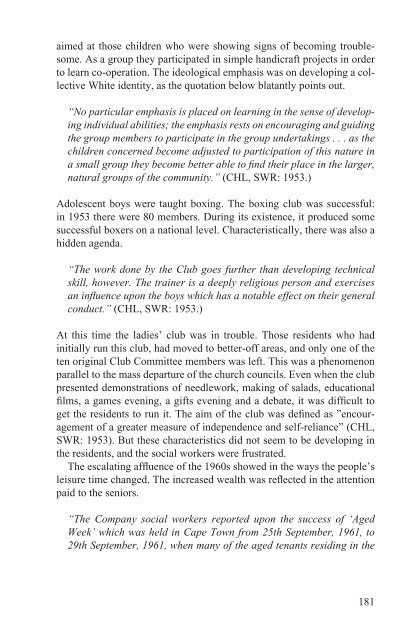The Making of a Good White - E-thesis - Helsinki.fi
The Making of a Good White - E-thesis - Helsinki.fi
The Making of a Good White - E-thesis - Helsinki.fi
You also want an ePaper? Increase the reach of your titles
YUMPU automatically turns print PDFs into web optimized ePapers that Google loves.
aimed at those children who were showing signs <strong>of</strong> becoming troublesome.<br />
As a group they participated in simple handicraft projects in order<br />
to learn co-operation. <strong>The</strong> ideological emphasis was on developing a collective<br />
<strong>White</strong> identity, as the quotation below blatantly points out.<br />
“No particular emphasis is placed on learning in the sense <strong>of</strong> developing<br />
individual abilities; the emphasis rests on encouraging and guiding<br />
the group members to participate in the group undertakings . . . as the<br />
children concerned become adjusted to participation <strong>of</strong> this nature in<br />
a small group they become better able to <strong>fi</strong> nd their place in the larger,<br />
natural groups <strong>of</strong> the community.” (CHL, SWR: 1953.)<br />
Adolescent boys were taught boxing. <strong>The</strong> boxing club was successful:<br />
in 1953 there were 80 members. During its existence, it produced some<br />
successful boxers on a national level. Characteristically, there was also a<br />
hidden agenda.<br />
“<strong>The</strong> work done by the Club goes further than developing technical<br />
skill, however. <strong>The</strong> trainer is a deeply religious person and exercises<br />
an infl uence upon the boys which has a notable effect on their general<br />
conduct.” (CHL, SWR: 1953.)<br />
At this time the ladies’ club was in trouble. Those residents who had<br />
initially run this club, had moved to better-<strong>of</strong>f areas, and only one <strong>of</strong> the<br />
ten original Club Committee members was left. This was a phenomenon<br />
parallel to the mass departure <strong>of</strong> the church councils. Even when the club<br />
presented demonstrations <strong>of</strong> needlework, making <strong>of</strong> salads, educational<br />
<strong>fi</strong>lms, a games evening, a gifts evening and a debate, it was dif<strong>fi</strong>cult to<br />
get the residents to run it. <strong>The</strong> aim <strong>of</strong> the club was de<strong>fi</strong>ned as ”encouragement<br />
<strong>of</strong> a greater measure <strong>of</strong> independence and self-reliance” (CHL,<br />
SWR: 1953). But these characteristics did not seem to be developing in<br />
the residents, and the social workers were frustrated.<br />
<strong>The</strong> escalating affluence <strong>of</strong> the 1960s showed in the ways the people’s<br />
leisure time changed. <strong>The</strong> increased wealth was reflected in the attention<br />
paid to the seniors.<br />
“<strong>The</strong> Company social workers reported upon the success <strong>of</strong> ‘Aged<br />
Week’ which was held in Cape Town from 25th September, 1961, to<br />
29th September, 1961, when many <strong>of</strong> the aged tenants residing in the<br />
181
















